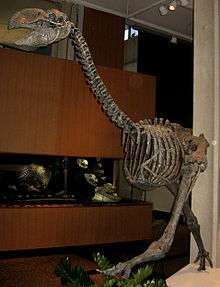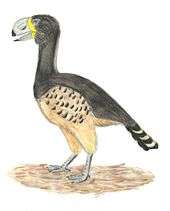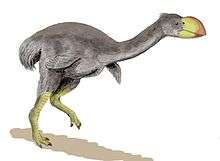Anseriformes
Anseriformes is an order of birds that comprise about 180 living species in three families: Anhimidae (the 3 screamers), Anseranatidae (the magpie goose), and Anatidae, the largest family, which includes over 170 species of waterfowl, among them the ducks, geese, and swans. Most modern species in the order are highly adapted for an aquatic existence at the water surface. With the exception of screamers, all have phalli, a trait that has been lost in the Neoaves. Due to their aquatic nature, most species are web-footed.
| Anseriformes | |
|---|---|
 | |
| Magpie goose, Anseranas semipalmata | |
| Scientific classification | |
| Kingdom: | Animalia |
| Phylum: | Chordata |
| Class: | Aves |
| Clade: | Anserimorphae |
| Order: | Anseriformes Wagler, 1831 |
| Extant families | |
 | |
| Range of the waterfowl and allies | |
Evolution
Anseriformes are one of only two types of modern bird to be confirmed present during the Mesozoic alongside the other dinosaurs, and in fact were among the very few birds to survive their extinction, along with their cousins the galliformes. These two groups only occupied two ecological niches during the Mesozoic, living in water and on the ground, while the toothed enantiornithes were the dominant birds that ruled the trees and air. The asteroid that ended the Mesozoic destroyed all trees as well as animals in the open, a condition that took centuries to recover from. The anseriformes and galliformes are thought to have survived in the cover of burrows and water, and not to have needed trees for food and reproduction.[1]
The earliest Cretaceous anseriform found so far is Vegavis, a goose-like waterfowl thought to have lived as long as 99 million years ago.[2] Some members apparently surviving the KT extinction event, including presbyornithids, thought to be the common ancestors of ducks, geese, swans, and screamers, the last group once thought to be galliformes, but now genetically confirmed to be closely related to geese. The first known duck fossils start to appear about 34 million years ago.
Waterfowl are the best-known examples of sexually antagonistic genital coevolution in vertebrates, causing genital adaptations coevolve in each sex to advance control over mating and fertilization. Sexually antagonistic coevolution (or SAC) occurs as a consequence of sexual conflict between males and females, resulting in coevolutionary process that reduce fit, or that functions to decrease ease of having sex.[3]
Taxonomy
The Anseriformes and the Galliformes (pheasants, etc.) are the most primitive neognathous birds, and should follow ratites and tinamous in bird classification systems. Together they belong to the Galloanserae. Several unusual extinct families of birds like the albatross-like pseudotooth birds and the giant flightless gastornithids and mihirungs have been found to be stem-anseriforms based on common features found in the skull region, beak physiology and pelvic region.[4][5][6][7][8][9] The genus Vegavis for a while was found to be the earliest member of the anseriform crown group but a recent 2017 paper has found it to be just outside the crown group in the family Vegaviidae.[10]
Below is the general consensus of the phylogeny of anseriforms and their stem relatives.[4][5][6][7][8][10]
| Odontoanserae |
| ||||||||||||||||||||||||
Systematics
Anatidae systematics, especially regarding placement of some "odd" genera in the dabbling ducks or shelducks, is not fully resolved. See the Anatidae article for more information, and for alternate taxonomic approaches. Anatidae is traditionally divided into subfamilies Anatinae and Anserinae.[11] The Anatinae consists of tribes Anatini, Aythyini, Mergini and Tadornini. The higher-order classification below follows a phylogenetic analysis performed by Mikko's Phylogeny Archive[12][13] and John Boyd's website.[14]
- Order Anseriformes
- ?†Conflicto Claudia P. Tambussi et al. 2019
- †Naranbulagornis Zelenkov 2019
- Suborder Anhimae Wetmore & Miller 1926
- Genus †Chaunoides de Alvarenga 1999
- Family Anhimidae Stejneger 1885 (screamers)
- Genus Anhima (Linnaeus 1766) Brisson 1760 [Anhima minuta; Palamedea cornuta Linnaeus 1766] (Horned screamer)
- Genus Chauna Illiger 1811
- Suborder Anseres (true anseriformes)
- Superfamily Anseranatoidea
- Family Anseranatidae Sclater 1880
- Genus †Anserpica Mourer-Chauviré, Berthet & Hugueney 2004
- Genus †Eoanseranas Worthy & Scanlon 2009 (Hand's dawn magpie goose)
- Genus †Anatalavis Olson & Parris 1987 [Nettapterornis Mlikovsky 2002; Telmatornis Shufeldt 1915] (Late Cretaceous/Early Paleocene – Early Eocene)
- Genus Anseranas (Latham 1798) Lesson 1828 [Chenogeranus Brown 1842; Choristopus Eyton 1838] (Magpie goose)
- Family Anseranatidae Sclater 1880
- Superfamily Anatoidea
- Family †Presbyornithidae Wetmore 1926 (wading-"geese")^
- Genus †Teviornis Kuročkin, Dyke & Karhu 2002
- Genus †Telmabates Howard 1955
- Genus †Headonornis (Lydekker 1891) Harrison & Walker 1976 [Agnopterus hantoniensis Lydekker 1891; Ptenornis Seeley 1866; ?Presbyornis isoni (Dyke 2001)]
- Genus †Presbyornis Wetmore 1926 [Nautilornis Wetmore 1926; Coltonia Hardy 1959]
- Genus †Wilaru Boles et al. 2013
- Family †Paranyrocidae Miller & Compton 1939
- Genus †Paranyroca Miller & Compton 1939 (Rosebud Early Miocene of Bennett County, USA)
- Family Anatidae Leach 1820 (almost 150 species)
- Subfamily †Romainvilliinae Lambrecht 1933
- Genus †Romainvillia Lebedinský 1927 (Late Eocene/Early Oligocene)
- Genus †Saintandrea Mayr & De Pietri 2013
- Subfamily Dendrocygninae Reichenbach 1849–50
- Genus Dendrocygna Swainson 1837 (whistling ducks)
- Genus Thalassornis Eyton 1838 (White-backed duck)
- Subfamily †Dendrocheninae Livezey & Martin 1988
- Genus †Dendrochen Miller 1944
- Genus †Manuherikia Worthy et al. 2007
- Genus †Mionetta Livezey & Martin 1988
- Subfamily Stictonettinae
- Genus Stictonetta (Gould 1841) Reichenbach 1853 (Freckled duck)
- Subfamily Anserinae Vigors 1825 sensu Livezey 1996 (swans and geese)
- Genus †Anserobranta Kuročkin & Ganya 1972
- Genus †Asiavis Nesov 1986
- Genus †“Chenopis” De Vis 1905
- Genus †Cygnavus Lambrecht 1931
- Genus †Cygnopterus Lambrecht 1931
- Genus †Eremochen Brodkorb 1961
- Genus †Megalodytes Howard 1992
- Genus †Paracygnus Short 1969
- Genus †Presbychen Wetmore 1930
- Genus †Cnemiornis Owen 1866 (New Zealand Geese)
- Genus Coscoroba (Molina 1782) Reichenbach 1853 [Pseudolor Gray 1855] (Coscoroba swan)
- Genus Cereopsis Latham 1801 (Cape Barren goose)
- Genus Cygnus Garsault 1764 [Archaeocygnus De Vis 1905; Cygnanser Kretzoi 1957; Euolor Mathews & Iredale 1917; Palaeocygnus Oberholser 1908; Chenopis Wagler 1832]
- Genus †Afrocygnus chauvireae Louchart et al. 2005
- Genus Branta Scopoli 1769 [Brenthus Sundeval l1872 non Schoenherr 1826; Bernicla Oken 1817; Geochen Wetmore 1943; Nesochen Salvadori 1895]
- Tribe Anserini Vigors 1825
- Subfamily Tadorninae Reichenbach 1849–50 (shelducks and sheldgeese)
- Genus †Australotadorna Worthy 2009
- Genus †Brantadorna Howard 1964
- Genus †Centrornis Andrews 1897 (Malagasy sheldgoose)
- Genus †Miotadorna Worthy et al. 2007 (St. Bathans shelduck)
- Genus †Nannonetta Campbell 1979
- Genus †Pleistoanser Agnolín 2006
- Genus Plectropterus (Linnaeus 1766) (Spur-winged goose)
- Genus Merganetta Gould 1842 (Torrent duck)
- Genus Chloephaga Eyton 1838 [Foetopterus Moreno & Mercerat 1891]
- Genus Neochen Oberholser 1918
- Genus Cyanochen (Rüppell 1845) Bonaparte 1856 (Blue-winged goose)
- Genus Tadorna Boie 1822 [Vulpanser Keyserling & Blasius 1840; Zesarkaca Mathews 1937; Gennaeochen Heine & Reichenow 1890; Casarca Bonaparte 1838; Nettalopex Heine 1890]
- Genus Radjah Reichenbach, 1853
- Genus Alopochen Stejneger 1885 [Mascarenachen Cowles 1994; Proanser Umans'ka 1979a; Anserobranta Kuročkin & Ganya 1972; Chenalopex Stephens 1824 non Vieillot 1818]
- Genus Cairina (Linnaeus 1758) Fleming 1822 (Muscovy duck)
- Genus Hymenolaimus (Gmelin 1789) Gray 1843 (Blue duck)
- Genus Sarkidiornis Eyton 1838
- Genus Tachyeres Owen 1875 [Micropterus Lesson 1828 non Lacépède 1802; Microa Strand 1943] (Steamer ducks)
- Subfamily Anatinae Vigors 1825 sensu Livezey 1996
- Genus Aix Boie 1828 [Dendronessa Wagler 1832]
- Genus Callonetta Delacour 1936 (Ringed teal)
- Genus Chenonetta von Brandt 1836 (Australian wood duck)
- Genus Biziura Stephens 1824 (musk ducks)
- Genus Pteronetta (Cassin 1860) Salvadori 1895 (Hartlaub's duck)
- Genus Marmaronetta (Ménétries 1832) Reichenbach 1853 (Marbled duck)
- Genus Asarcornis (Müller 1842) Salvadori 1895 (White-winged duck)
- Genus Netta Kaup 1829 [Callichen Brehm 1830; Mergoides Eyton 1836; Netta (Rhodonessa) Reichenbach 1852]
- Genus Lophonetta (King 1828) Riley 1914 (Crested duck)
- Genus Amazonetta (Gmelin 1789) von Boetticher 1929 (Brazilian teal)
- Genus †Dunstanetta Worthy et al. 2007 (Johnstone's duck)
- Genus †Lavadytis Stidham & Hilton 2015
- Genus †Pinpanetta Worthy 2009
- Genus †Tirarinetta Worthy 2008
- Tribe Oxyurini Swainson 1831 (stiff-tailed ducks and allies)
- Genus Nettapus von Brandt 1836 [(Cheniscus) Eyton 1838; Anserella Gray 1855 non Selby 1840; ; Microcygna Gray 1840; ] (Pygmy geese)
- Genus †Anabernicula Ross 1935
- Genus Malacorhynchus Swainson 1831 (Pink-eared duck)
- Genus Salvadorina Rothschild & Hartert 1894 (Salvadori's teal)
- Genus Speculanas (King 1828) von Boetticher 1929 (Bronze-winged duck)
- Tribe Mergini Rafinesque 1815 (eiders, scoters, mergansers and other sea-ducks)
- Genus †Chendytes Miller 1925
- Genus †Shiriyanetta Watanabe & Matsuoka 2015
- Genus Histrionicus Lesson 1828 [Cosmonessa Kaup 1829; †Ocyplonessa Brodkorb 1961] (Harlequin duck)
- Genus †Camptorhynchus (Gmelin 1789) Bonaparte 1838 [Anas labradorius Gmelin 1789] (Labrador duck)
- Genus Clangula Leach 1819 (Long-tailed duck)
- Genus Polysticta stelleri (Pallas 1769) Eyton 1836 [Eniconetta Gray 1840; Stelleria Bonaparte 1842] (Steller's Eiders)
- Genus Somateria Leach 1819 [Platypus Brehm 1824 non Shaw 1799 non Herbst 1793; Erionetta Coues 1884; (Lampronetta) Brandt 1847] (Eiders)
- Genus Melanitta Boie 1822 [Phoenonetta Stone 1907; Ania Stephens 1824 non Stephens 1831; Maceranas Lesson 1828; Macroramphus Lesson 1828; Pelionetta Kaup 1829; (Oidemia) Fleming 1822] (Scoters)
- Genus Bucephala Baird 1858 [Charitonetta Stejneger 1885; Clanganas Oberholser 1974; Glaucion Kaup 1829 non Oken 1816; Bucephala (Glaucionetta) Stejneger 1885]
- Genus Mergellus Selby 1840 (Smew)
- Genus Lophodytes (Linnaeus 1758) Reichenbach 1853 (Hooded merganser)
- Genus Mergus Linnaeus 1758 non Brisson 1760 [(Promergus) Mathews & Iredale 1913; (Prister) Heine & Reichenow 1890]
- Tribe Anatini Vigors 1825 sensu Livezey 1996 (dabbling ducks and moa-nalos)
- Genus †Matanas Worthy et al. 2007 (Enright's duck)
- Genus Anas Linnaeus 1758 [Boschas Swainson 1831; Dafila Stephens 1824; Nettion Kaup 1829; Phasianurus Wagler 1832; Trachelonetta Kaup 1829; Anas (Dafila) Stephens 1824; Virago Newton 1871; Macera Swainson 1837; Penelops Kaup 1829; Mareca (Notonetta) Roberts 1922; Mareca (Chaulelasmus) Bonaparte 1838; Chauliodus Swainson 1831 non Bloch 1801; Ktinorhynchus Eyton 1838; Mareca (Eunetta) Bonaparte 1856; Horizonetta Oberholser 1917; Anas (Melananas) Roberts 1922; Anas (Afranas) Roberts 1922; Anas (Polionetta) Oates 1899 non Rondani 1856; Anas (Virago) Newton 1872; Elasmonetta Salvadori 1895; Xenonetta Fleming 1935; Anas (Paecilonitta) Eyton 1838; Aethiopinetta Boetticher 1943; Anas (Dafilonettio) Boettischer 1937]
- Genus Sibirionetta (Georgi 1775) (Baikal teal)
- Genus Mareca (Stephens 1824)
- Genus Spatula Boie 1822 [Anas (Pterocyanea) Bonaparte 1841; Querquedula Stephens 1824; Rhynchaspis Stephens 1824; Rhynchoplatus Berthold 1827; Cyanopterus Bonaparte 1838 non Haliday 1835; Clypeata Lesson 1828; Anas (Micronetta) Roberts 1922; Adelonetta Heine & Reichenow 1890]
- Tribe Aythyini Delacour and Mayr, 1945 (diving ducks)
- Subfamily †Romainvilliinae Lambrecht 1933
- Family †Presbyornithidae Wetmore 1926 (wading-"geese")^
- Superfamily Anseranatoidea
Some fossil anseriform taxa not assignable with certainty to a family are:
- †Proherodius (London Clay Early Eocene of London, England) – Presbyornithidae?
- †Garganornis ballmanni Meijer 2014
Unassigned Anatidae:
- †"Anas" albae Jánossy 1979 [?Mergus]
- †"Anas" amotape Campbell 1979
- †"Anas" isarensis Lambrecht 1933
- †"Anas" luederitzensis
- †"Anas" sanctaehelenae Campbell 1979
- †"Anas" eppelsheimensis Lambrecht 1933
- †"Oxyura" doksana Mlíkovský 2002
- †"Anser" scaldii ["Anas" scaldii]
- †Ankonetta larriestrai Cenizo & Agnolín 2010
- †Cayaoa bruneti Tonni 1979
- †Eoneornis nomen dubium
- †Eutelornis
- †Aldabranas cabri Harrison & Walker 1978
- †Chenoanas deserta Zelenkov 2012
- †Cygnopterus alphonsi Cheneval 1984 [non Cygnavus senckenbergi Mlíkovský 2002]
- †Helonetta brodkorbi Emslie 1992
- †Loxornis clivus Ameghino 1894
- †Mioquerquedula minutissima Zelenkov & Kuročkin 2012 [Anas velox Milne-Edwards 1867]
- †Paracygnopterus scotti Harrison & Walker 1979
- †Proanser major Umanskaya 1979
- †Teleornis Ameghino 1899
- †Protomelanitta Zelenkov 2011
- †Nogusunna conflictoides Zelenkov 2011
- †Sharganetta mongolica Zelenkov 2011
- Metopiana Bonaparte 1856 [Metopias Heine & Reichenow 1890; Phoeonetta Delacour 1937; Netta (Phoeoaythia) Delacour 1937]
- †Bambolinetta (Portis 1884) Mayr & Pavia 2014 [Anas lignitifila Portis 1884]
- †Heteroanser vicinus (Kuročkin 1976) Zelenkov 2012 [Heterochen vicinus Kuročkin 1976; Anser vicinus (Kuročkin 1976) Mlíkovský & Švec 1986]
- †Sinanas Yeh 1980
- †Talpanas Olson & James 2009 (Kaua'i mole duck)
- †Wasonaka Howard 1966
- †Chelychelynechen Olson & James 1991 (turtle-jawed moa-nalo)
- †Ptaiochen Olson & James 1991 (small-billed moa-nalo)
- †Thambetochen Olson & Wetmore 1976
In addition, a considerable number of mainly Late Cretaceous and Paleogene fossils have been described where it is uncertain whether or not they are anseriforms. This is because almost all orders of aquatic birds living today either originated or underwent a major radiation during that time, making it hard to decide whether some waterbird-like bone belongs into this family or is the product of parallel evolution in a different lineage due to adaptive pressures.
- "Presbyornithidae" gen. et sp. indet. (Barun Goyot Late Cretaceous of Udan Sayr, Mongolia) – Presbyornithidae?
- UCMP 117599 (Hell Creek Late Cretaceous of Bug Creek West, USA)
- Petropluvialis (Late Eocene of England) – may be same as Palaeopapia
- Agnopterus (Late Eocene – Late Oligocene of Europe) – includes Cygnopterus lambrechti
- "Headonornis hantoniensis" BMNH PAL 4989 (Hampstead Early Oligocene of Isle of Wight, England) – formerly "Ptenornis"
- Palaeopapia (Hampstead Early Oligocene of Isle of Wight, England)
- "Anas" creccoides (Early/Middle Oligocene of Belgium)
- "Anas" skalicensis (Early Miocene of "Skalitz", Czech Republic)
- "Anas" risgoviensis (Late Miocene of Bavaria, Germany)
- †"Anas" meyerii Milne-Edwards 1867 [Aythya meyerii (Milne-Edwards 1867) Brodkorb 1964]
- †Eonessa anaticula Wetmore 1938 {Eonessinae Wetmore 1938}
Phylogeny
Living Anseriformes based on the work by John Boyd.[14]
| Anseriformes classification | |||||||||||||||||||||||||||||||||||||||||||||||||||||||||||||||||||||||||||||||||||||||||||||||||||||||||||||||||||||||||||||||||||||||||||||||||||||||||||||||||||||||||||||||||||||||||||||||||||||||||||||||||||||||||||||||||||||||||||||||||||||||||||||||||||||||||||||||||||||||||||||||||||||||||||||||||||||||||||||||||||||||||||||||||||||||||||||||
|---|---|---|---|---|---|---|---|---|---|---|---|---|---|---|---|---|---|---|---|---|---|---|---|---|---|---|---|---|---|---|---|---|---|---|---|---|---|---|---|---|---|---|---|---|---|---|---|---|---|---|---|---|---|---|---|---|---|---|---|---|---|---|---|---|---|---|---|---|---|---|---|---|---|---|---|---|---|---|---|---|---|---|---|---|---|---|---|---|---|---|---|---|---|---|---|---|---|---|---|---|---|---|---|---|---|---|---|---|---|---|---|---|---|---|---|---|---|---|---|---|---|---|---|---|---|---|---|---|---|---|---|---|---|---|---|---|---|---|---|---|---|---|---|---|---|---|---|---|---|---|---|---|---|---|---|---|---|---|---|---|---|---|---|---|---|---|---|---|---|---|---|---|---|---|---|---|---|---|---|---|---|---|---|---|---|---|---|---|---|---|---|---|---|---|---|---|---|---|---|---|---|---|---|---|---|---|---|---|---|---|---|---|---|---|---|---|---|---|---|---|---|---|---|---|---|---|---|---|---|---|---|---|---|---|---|---|---|---|---|---|---|---|---|---|---|---|---|---|---|---|---|---|---|---|---|---|---|---|---|---|---|---|---|---|---|---|---|---|---|---|---|---|---|---|---|---|---|---|---|---|---|---|---|---|---|---|---|---|---|---|---|---|---|---|---|---|---|---|---|---|---|---|---|---|---|---|---|---|---|---|---|---|---|---|---|---|---|---|---|---|---|---|---|---|---|---|---|---|---|---|---|---|---|---|---|---|---|---|---|---|---|---|---|---|---|---|---|---|---|---|---|
|
 Crested screamer (Chauna torquata)
Crested screamer (Chauna torquata) Magpie goose (Anseranas semipalmata), sole surviving member of a Mesozoic lineage
Magpie goose (Anseranas semipalmata), sole surviving member of a Mesozoic lineage Cast of Dromornis stirtoni, a mihirung, from Australia.
Cast of Dromornis stirtoni, a mihirung, from Australia.
Molecular studies
Studies of the mitochnodrial DNA suggest the existence of four branches – Anseranatidae, Dendrocygninae, Anserinae and Anatinae – with Dendrocygninae being a subfamily within the family Anatidae and Anseranatidae representing an independent family.[15] The clade Somaterini has a single genus Somateria.
References
- Quail-like creatures were the only birds to survive the dinosaur-killing asteroid impact
- The Delaware River: History, Traditions and Legends
- Brennan, Patricia L.R.; Prum, Richard O. (July 2015). "Mechanisms and Evidence of Genital Coevolution: The Roles of Natural Selection, Mate Choice, and Sexual Conflict". Cold Spring Harbor Perspectives in Biology. 7 (7): a017749. doi:10.1101/cshperspect.a017749. ISSN 1943-0264. PMC 4484975. PMID 26134314.
- Andors, A. (1992). "Reappraisal of the Eocene groundbird Diatryma (Aves: Anserimorphae)". Science Series Natural History Museum of Los Angeles County. 36: 109–125.
- Murrary, P.F; Vickers-Rich, P. (2004). Magnificent Mihirungs: The Colossal Flightless Birds of the Australian Dreamtime. Indiana University Press.
- Bourdon, E. (2005). "Osteological evidence for sister group relationship between pseudo-toothed birds (Aves: Odontopterygiformes) and waterfowls (Anseriformes)". Naturwissenschaften. 92 (12): 586–91. doi:10.1007/s00114-005-0047-0. PMID 16240103.
- Agnolín, F. (2007). "Brontornis burmeisteri Moreno & Mercerat, un Anseriformes (Aves) gigante del Mioceno Medio de Patagonia, Argentina". Revista del Museo Argentino de Ciencias Naturales. 9: 15–25. doi:10.22179/revmacn.9.361.
- Livezey, B.C.; Zusi, R.L. (2007). "Higher-order phylogeny of modern birds (Theropoda, Aves: Neornithes) based on comparative anatomy. II. Analysis and discussion". The Science of Nature. 149 (1): 1–95. doi:10.1111/j.1096-3642.2006.00293.x. PMC 2517308. PMID 18784798.
- Louchart, A.; Sire, J.-Y.; Mourer-Chauviré, C.; Geraads, D.; Viriot, L.; de Buffrénil, V. (2013). "Structure and Growth Pattern of Pseudoteeth in Pelagornis mauretanicus (Aves, Odontopterygiformes, Pelagornithidae)". PLoS ONE. 8 (11): e80372. doi:10.1371/journal.pone.0080372. PMC 3828250. PMID 24244680.
- Agnolín, F.L.; Egli, F.B.; Chatterjee, S.; Marsà, J.A.G (2017). "Vegaviidae, a new clade of southern diving birds that survived the K/T boundary". The Science of Nature. 104 (87): 87. doi:10.1007/s00114-017-1508-y. PMID 28988276.
- Gonzalez, J.; Düttmann, H.; Wink, M. (2009). "Phylogenetic relationships based on two mitochondrial genes and hybridization patterns in Anatidae". Journal of Zoology. 279 (3): 310–318. doi:10.1111/j.1469-7998.2009.00622.x.
- Mikko's Phylogeny Archive Haaramo, Mikko (2007). "Anseriformes – waterfowls". Retrieved 30 December 2015.
- Paleofile.com (net, info) "Archived copy". Archived from the original on 2016-01-11. Retrieved 2015-12-30.CS1 maint: archived copy as title (link). "Taxonomic lists- Aves". Archived from the original on 11 January 2016. Retrieved 30 December 2015.
- John Boyd's website Boyd, John (2007). "Anseriformes – waterfowl". Retrieved 30 December 2015.
- Liu, G; Zhou, L; Zhang, L; Luo, Z; Xu, W (2013). "The complete mitochondrial genome of bean goose (Anser fabalis) and implications for anseriformes taxonomy". PLoS ONE. 8 (5): e63334. doi:10.1371/journal.pone.0063334. PMC 3662773. PMID 23717412.
Cited texts
| Wikimedia Commons has media related to Anseriformes. |
| The Wikibook Dichotomous Key has a page on the topic of: Anseriformes |
- Agnolin, F (2007). "Brontornis burmeisteri Moreno & Mercerat, un Anseriformes (Aves) gigante del Mioceno Medio de Patagonia, Argentina". Revista del Museo Argentino de Ciencias Naturales. 9: 15–25. doi:10.22179/revmacn.9.361.
- Clarke, J. A.; Tambussi, C. P.; Noriega, J. I.; Erickson, G. M.; Ketcham, R. A. (2005). "Definitive fossil evidence for the extant avian radiation in the Cretaceous". Nature. 433 (7023): 305–308. doi:10.1038/nature03150. PMID 15662422.
- Livezey, B. C.; Zusi, R. L. (2007). "Higher-order phylogeny of modern birds (Theropoda, Aves: Neornithes) based on comparative anatomy. II. Analysis and discussion". Zoological Journal of the Linnean Society. 149 (1): 1–95. doi:10.1111/j.1096-3642.2006.00293.x. PMC 2517308. PMID 18784798.
- Murray, P. F. & Vickers-Rich, P. (2004) Magnificent Mihirungs: The Colossal Flightless Birds of the Australian Dreamtime. Indiana University Press.





.jpg)






_(flipped).jpg)
.jpg)

.jpg)

_-_Mergellus_albellus_(flipped).jpg)

